Land Use Changes in the Teles Pires River Basin’s Amazon and Cerrado Biomes, Brazil, 1986–2020
Abstract
1. Introduction
2. Using Remotely Sensed Data for Conservation
3. Materials and Methods
3.1. Study Area
3.2. Spatial Data Sources
3.3. Mapping Land Use
3.4. Mapping Validation
4. Results
5. Discussion
5.1. Potential Misclassifications and Comparisons to Previous Studies
5.2. Agricultural Development Policies and Future Sustainable Intensification
5.3. Policy Implications
6. Conclusions
Author Contributions
Funding
Institutional Review Board Statement
Informed Consent Statement
Data Availability Statement
Acknowledgments
Conflicts of Interest
Appendix A
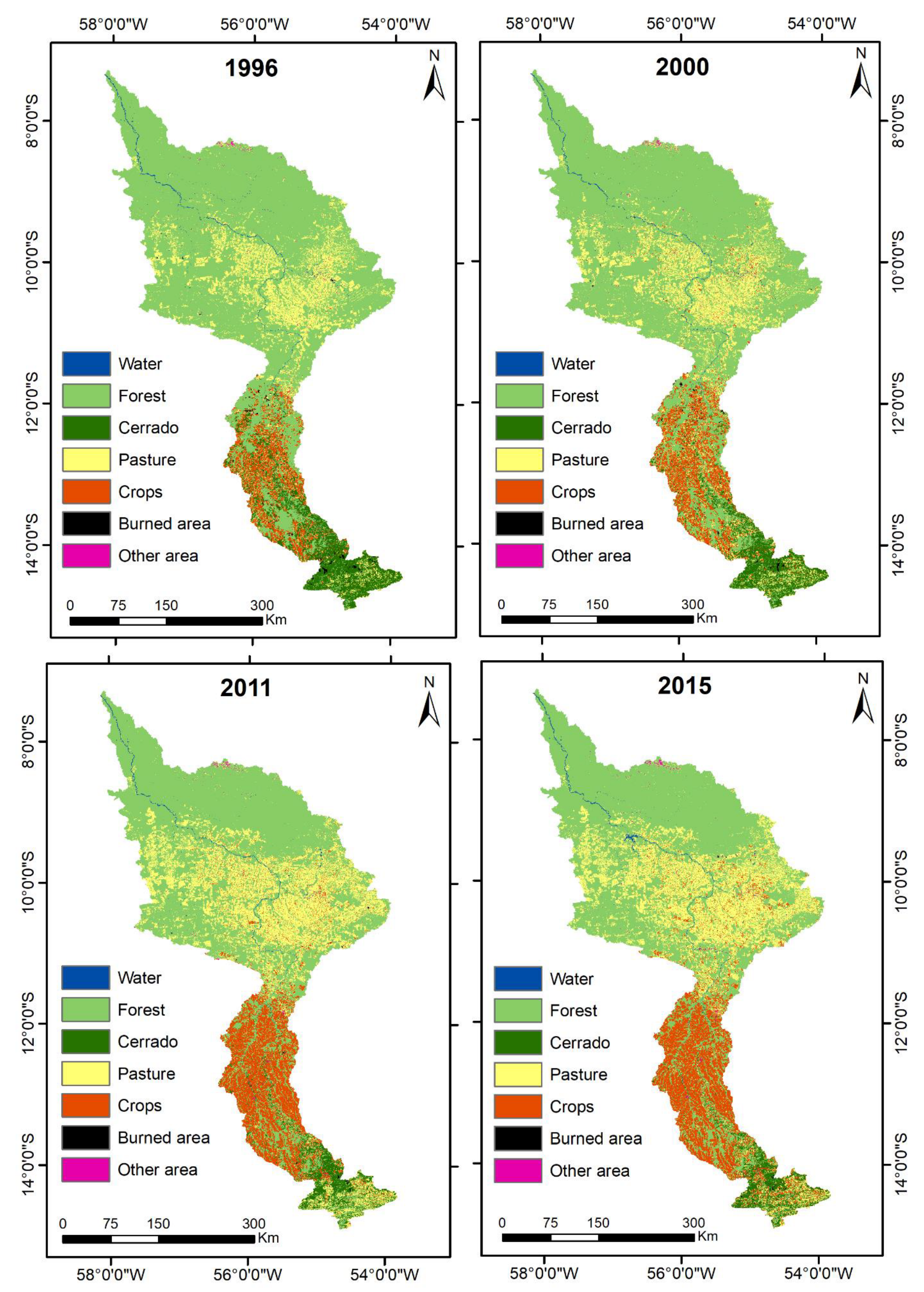

| MapBiomas | ||||||||
|---|---|---|---|---|---|---|---|---|
| 1986 | Water | Forest | Cerrado | Pasture | Crops | Other area | Total | UA (%) |
| Water | 1419 | 0 | 0 | 0 | 0 | 0 | 1419 | 100.00 |
| Forest | 0 | 20,023 | 12 | 0 | 0 | 0 | 20,035 | 99.94 |
| Cerrado | 0 | 1281 | 2199 | 0 | 0 | 0 | 3480 | 63.19 |
| Pasture | 0 | 0 | 3 | 1455 | 8 | 44 | 1510 | 96.36 |
| Crops | 0 | 0 | 0 | 26 | 1475 | 149 | 1650 | 89.39 |
| Other area | 21 | 0 | 22 | 159 | 28 | 373 | 603 | 61.86 |
| Total | 1440 | 21,304 | 2236 | 1640 | 1511 | 566 | 28,697 | |
| PA (%) | 98.54 | 93.99 | 98.35 | 88.72 | 97.62 | 65.90 | ||
| Overall accuracy (%): | 93.89 | Kappa Index: | 0.87 | |||||
| 1991 | Water | Forest | Cerrado | Pasture | Crops | Other area | Total | UA (%) |
| Water | 1870 | 1 | 0 | 0 | 0 | 0 | 1871 | 99.95 |
| Forest | 0 | 18,678 | 5 | 0 | 0 | 0 | 18,683 | 99.97 |
| Cerrado | 0 | 1120 | 2461 | 0 | 0 | 0 | 3581 | 68.72 |
| Pasture | 0 | 0 | 0 | 3087 | 216 | 12 | 3315 | 93.12 |
| Crops | 0 | 0 | 0 | 45 | 2939 | 158 | 3142 | 93.54 |
| Other area | 9 | 0 | 42 | 433 | 12 | 335 | 831 | 40.31 |
| Total | 1879 | 19,799 | 2508 | 3565 | 3167 | 505 | 31,423 | |
| PA (%) | 99.52 | 94.34 | 98.13 | 86.59 | 92.80 | 66.34 | ||
| Overall accuracy (%): | 93.47 | Kappa Index: | 0.89 | |||||
| 1996 | Water | Forest | Cerrado | Pasture | Crops | Other area | Total | UA (%) |
| Water | 1306 | 0 | 0 | 0 | 0 | 0 | 1306 | 100.00 |
| Forest | 0 | 21,211 | 1 | 26 | 0 | 0 | 21,238 | 99.87 |
| Cerrado | 0 | 2229 | 1491 | 0 | 0 | 0 | 3720 | 40.08 |
| Pasture | 0 | 1 | 0 | 4030 | 17 | 71 | 4119 | 97.84 |
| Crops | 0 | 0 | 0 | 32 | 831 | 31 | 894 | 92.95 |
| Other area | 0 | 0 | 34 | 165 | 80 | 443 | 722 | 61.36 |
| Total | 1306 | 23,441 | 1526 | 4253 | 928 | 545 | 31,999 | |
| PA (%) | 100.00 | 90.49 | 97.71 | 94.76 | 89.55 | 81.28 | ||
| Overall accuracy (%): | 91.60 | Kappa Index: | 0.83 | |||||
| 2000 | Water | Forest | Cerrado | Pasture | Crops | Other area | Total | UA (%) |
| Water | 2049 | 1 | 0 | 0 | 0 | 0 | 2050 | 99.95 |
| Forest | 0 | 19,774 | 9 | 0 | 0 | 0 | 19,783 | 99.95 |
| Cerrado | 0 | 1320 | 2355 | 0 | 0 | 0 | 3675 | 64.08 |
| Pasture | 0 | 0 | 0 | 4791 | 64 | 27 | 4882 | 98.14 |
| Crops | 0 | 0 | 9 | 113 | 4121 | 176 | 4419 | 93.26 |
| Other area | 14 | 5 | 0 | 85 | 22 | 401 | 527 | 76.09 |
| Total | 2063 | 21,100 | 2373 | 4989 | 4207 | 604 | 35,336 | |
| PA (%) | 99.32 | 93.72 | 99.24 | 96.03 | 97.96 | 66.39 | ||
| Overall accuracy (%): | 94.78 | Kappa Index: | 0.92 | |||||
| MapBiomas | ||||||||
|---|---|---|---|---|---|---|---|---|
| 2005 | Water | Forest | Cerrado | Pasture | Crops | Other area | Total | UA (%) |
| Water | 737 | 0 | 0 | 0 | 0 | 0 | 737 | 100.00 |
| Forest | 0 | 20,805 | 77 | 0 | 0 | 0 | 20,882 | 99.63 |
| Cerrado | 0 | 1302 | 1422 | 1 | 0 | 0 | 2725 | 52.18 |
| Pasture | 0 | 0 | 0 | 4110 | 117 | 11 | 4238 | 96.98 |
| Crops | 0 | 0 | 0 | 72 | 3931 | 129 | 4132 | 95.14 |
| Other area | 14 | 0 | 0 | 38 | 34 | 445 | 531 | 83.80 |
| Total | 751 | 22,107 | 1499 | 4221 | 4082 | 585 | 33,245 | |
| PA (%) | 98.14 | 94.11 | 94.86 | 97.37 | 96.30 | 76.07 | ||
| Overall accuracy (%): | 94.60 | Kappa Index: | 0.90 | |||||
| 2011 | Water | Forest | Cerrado | Pasture | Crops | Other area | Total | UA (%) |
| Water | 803 | 0 | 0 | 0 | 0 | 0 | 803 | 100.00 |
| Forest | 0 | 23,060 | 107 | 0 | 0 | 0 | 23,167 | 99.54 |
| Cerrado | 0 | 904 | 2519 | 0 | 0 | 0 | 3423 | 73.59 |
| Pasture | 0 | 2 | 214 | 4157 | 46 | 6 | 4425 | 93.94 |
| Crops | 0 | 0 | 0 | 57 | 3081 | 167 | 3305 | 93.22 |
| Other area | 17 | 2 | 0 | 43 | 10 | 436 | 508 | 85.83 |
| Total | 820 | 23,968 | 2840 | 4257 | 3137 | 609 | 35,631 | |
| PA (%) | 97.93 | 96.21 | 88.70 | 97.65 | 98.21 | 71.59 | ||
| Overall accuracy (%): | 95.58 | Kappa Index: | 0.92 | |||||
| 2015 | Water | Forest | Cerrado | Pasture | Crops | Other area | Total | UA (%) |
| Water | 1160 | 0 | 0 | 0 | 0 | 0 | 1160 | 100.00 |
| Forest | 0 | 19,801 | 55 | 0 | 0 | 0 | 19,856 | 99.72 |
| Cerrado | 0 | 1116 | 1668 | 0 | 0 | 11 | 2795 | 59.68 |
| Pasture | 0 | 0 | 8 | 3720 | 138 | 44 | 3910 | 95.14 |
| Crops | 0 | 0 | 0 | 77 | 4242 | 146 | 4465 | 95.01 |
| Other area | 10 | 0 | 15 | 50 | 51 | 468 | 594 | 78.79 |
| Total | 1170 | 20,917 | 1746 | 3847 | 4431 | 669 | 32,780 | |
| PA (%) | 99.15 | 94.66 | 95.53 | 96.70 | 95.73 | 69.96 | ||
| Overall accuracy (%): | 94.75 | Kappa Index: | 0.91 | |||||
| 2020 | Water | Forest | Cerrado | Pasture | Crops | Other area | Total | UA (%) |
| Water | 1541 | 0 | 0 | 0 | 0 | 0 | 1541 | 100.00 |
| Forest | 0 | 19,907 | 100 | 1 | 0 | 0 | 20,008 | 99.50 |
| Cerrado | 0 | 144 | 3917 | 205 | 0 | 0 | 4266 | 91.82 |
| Pasture | 0 | 0 | 4 | 3864 | 470 | 0 | 4338 | 89.07 |
| Crops | 2 | 0 | 0 | 38 | 3280 | 143 | 3463 | 94.72 |
| Other area | 64 | 10 | 4 | 0 | 0 | 737 | 815 | 90.43 |
| Total | 1607 | 20,061 | 4025 | 4108 | 3750 | 880 | 34,431 | |
| PA (%) | 95.89 | 99.23 | 97.32 | 94.06 | 87.47 | 83.75 | ||
| Overall accuracy (%): | 96.56 | Kappa Index: | 0.94 | |||||
References
- Verma, A.K. Sustainable Development and Environmental Ethics. Int. J. Environ. Sci. 2019, 10, 1–5. Available online: https://ssrn.com/abstract=3689046 (accessed on 1 July 2022).
- Araújo Neto, J.R.; Andrade, E.M.; Palácio, H.A.Q.; Sales, M.M.; Maia, A.R.S. Influence of land use/occupation on water quality in the Trussu river valley, Ceará, Brazil. Rev. Ciênc. Agron. 2017, 48, 59–69. [Google Scholar] [CrossRef]
- Shi, P.; Zhang, Y.; Li, Z.; Li, P.; Xu, G. Influence of land use and land cover patterns on seasonal water quality at multi-spatial scales. Catena 2017, 151, 182–190. [Google Scholar] [CrossRef]
- McMillan, H.; Montanari, A.; Cudennec, C.; Savenije, H.; Kreibich, H.; Krueger, T.; Liu, J.; Mejia, A.; Van Loon, A.F.; Aksoy, H.; et al. Panta Rhei 2013–2015: Global perspectives on hydrology, society and change. Hydrol. Sci. J. 2016, 61, 1174–1191. [Google Scholar] [CrossRef]
- Van Loon, A.F.; Rangecroft, S.; Coxon, G.; Naranjo, J.A.B.; Van Ogtrop, F.; Van Lanen, H.A.J. Using paired catchments to quantify the human influence on hydrological droughts. Hydrol. Earth Syst. Sci. 2019, 23, 1725–1739. [Google Scholar] [CrossRef]
- Joly, C.A.; Scarano, F.R.; Bustamante, M.; Gadda, T.M.C.; Metzger, J.P.W.; Seixas, C.S.; Ometto, J.P.H.B.; Pires, A.P.F.; Boesing, A.L.; Sousa, F.D.R.; et al. Brazilian assessment on biodiversity and ecosystem services: Summary for policy makers. Biota Neotrop. 2019, 19, e20190865. [Google Scholar] [CrossRef]
- Silva, C.M. Entre Fênix e Ceres: A grande aceleração e a fronteira agrícola no Cerrado. Var. Hist. 2018, 34, 409–444. [Google Scholar] [CrossRef]
- Lathuillière, M.J.; Coe, M.T.; Johnson, M.S. A review of green- and blue-water resources and their trade-offs for future agricultural production in the Amazon Basin: What could irrigated agriculture mean for Amazonia? Hydrol. Earth Syst. Sci. 2016, 20, 2179–2194. [Google Scholar] [CrossRef]
- Butler, D.; Ward, S.; Sweetapple, C.; Astaraie-Imani, M.; Diao, K.; Farmani, R.; Fu, G. Reliable, resilient and sustainable water management: The Safe & SuRe approach. Glob. Chall. 2016, 1, 63–77. [Google Scholar] [CrossRef]
- Rogan, J.; Chen, D. Remote sensing technology for mapping and monitoring land-cover and land-use change. Prog. Plann. 2004, 61, 301–325. [Google Scholar] [CrossRef]
- Liping, C.; Yujun, S.; Saeed, S. Monitoring and predicting land use and land cover changes using remote sensing and GIS techniques—A case study of a hilly area, Jiangle, China. PloS ONE 2018, 13, e0200493. [Google Scholar] [CrossRef]
- Rwanga, S.S.; Ndambuki, J.M. Accuracy Assessment of Land Use/Land Cover Classification Using Remote Sensing and GIS. Int. J. Geosci. 2017, 8, 611–622. [Google Scholar] [CrossRef]
- Mahmon, N.A.; Ya’acob, N.; Yusof, A.L. Differences of image classification techniques for land use and land cover classification. In Proceedings of the 2015 IEEE 11th International Colloquium on Signal Processing & Its Applications (CSPA), Kuala Lumpur, Malaysia, 6–8 March 2015; pp. 90–94. [Google Scholar] [CrossRef]
- Murad, C.A.; Pearse, J. Landsat study of deforestation in the Amazon region of Colombia: Departments of Caquetá and Putumayo Remote Sens. Appl. Soc. Environ. 2018, 11, 161–171. [Google Scholar] [CrossRef]
- Brovelli, M.A.; Sun, Y.; Yordanov, V. Monitoring Forest Change in the Amazon Using Multi-Temporal Remote Sensing Data and Machine Learning Classification on Google Earth Engine. ISPRS Int. J. Geo-Inf. 2020, 9, 580. [Google Scholar] [CrossRef]
- Zaiatz, A.P.S.R.; Zolin, C.A.; Vendrusculo, L.G.; Lopes, T.R.; Paulino, J. Agricultural land use and cover change in the Cerrado/Amazon ecotone: A case study of the upper Teles Pires river basin. Acta Amazon. 2018, 48, 168–177. [Google Scholar] [CrossRef]
- Ge, Y.; Hu, S.; Ren, Z.; Jia, Y.; Wang, J.; Liu, M.; Zhang, D.; Zhao, W.; Luo, Y.; Fu, Y.; et al. Mapping annual land use changes in China’s poverty-stricken areas from 2013 to 2018. Remote Sens. Environ. 2019, 232, e111285. [Google Scholar] [CrossRef]
- Rawat, J.S.; Kumar, M. Monitoring land use/cover change using remote sensing and GIS techniques: A case study of Hawalbagh block, district Almora, Uttarakhand, India. Egypt. J. Remote Sens. Space Sci. 2015, 18, 77–84. [Google Scholar] [CrossRef]
- Kar, R.; Obi Reddy, G.P.; Kumar, N.; Singh, S.K. Monitoring spatio-temporal dynamics of urban and peri-urban landscape using remote sensing and GIS—A case study from Central India. Egypt. J. Remote Sens. Space Sci. 2018, 21, 401–411. [Google Scholar] [CrossRef]
- Neves, A.K.; Korting, T.S.; Fonseca, L.M.G.; Escada, M.I.S. Assessment of TerraClass and MapBiomas data on legend and map agreement for the Brazilian Amazon biome. Acta Amazon. 2020, 50, 170–182. [Google Scholar] [CrossRef]
- Souza, A.P.; Mota, L.L.; Zamadei, T.; Martim, C.C.; Almeida, F.T.; Paulino, J. Climate classification and climatic water balance in Mato Grosso state, Brazil. Nativa. 2013, 1, 34–43. Available online: https://periodicoscientificos.ufmt.br/ojs/index.php/nativa/article/view/1334 (accessed on 1 July 2022). [CrossRef]
- Kuemmerle, T.; Erb, K.; Meyfroidt, P.; Müller, D.; Verburg, P.H.; Estel, S.; Haberl, H.; Hostert, P.; Jepsen, M.R.; Kastner, T.; et al. Challenges and opportunities in mapping land use intensity globally. Curr. Opin. Environ. Sustain. 2013, 5, 484–493. [Google Scholar] [CrossRef] [PubMed]
- Souza, S.O. Geotechnologies applied to time-space analysis of land use and occupation in coastal plain of Caravelas (BA). Goiano Bull. Geogr. 2015, 35, 71–89. [Google Scholar] [CrossRef]
- Wulder, M.A.; Roy, D.P.; Radeloff, V.C.; Loveland, T.R.; Anderson, M.C.; Johnson, D.M.; Healey, S.; Zhu, Z.; Scambos, T.A.; Pahlevan, N.; et al. Fifty years of Landsat science and impacts. Remote Sens. Environ. 2022, 280, 113195. [Google Scholar] [CrossRef]
- Showstack, R. Landsat 9 Satellite Continues Half-Century of Earth Observations: Eyes in the sky serve as a valuable tool for stewardship. BioScience 2022, 72, 226–232. [Google Scholar] [CrossRef]
- Jog, S.; Dixit, M. Supervised classification of satellite images. In Proceedings of the 2016 Conference on Advances in Signal Processing (CASP), Pune, India, 9–11 June 2016; pp. 93–98. [Google Scholar] [CrossRef]
- Ali, M.Z.; Qazi, W.; Aslam, N. A comparative study of ALOS-2 PALSAR and landsat-8 imagery for landcover classification using maximum likelihood classifier. Egypt. J. Remote Sens. Space Sci. 2018, 21, 329–330. [Google Scholar] [CrossRef]
- Shalaby, A.; Tateishi, R. Remote sensing and GIS for mapping and monitoring land cover and land-use changes in the Northwestern coastal zone of Egypt. Appl. Geogr. 2007, 27, 28–41. [Google Scholar] [CrossRef]
- Asokan, A.; Anitha, J.; Ciobanu, M.; Gabor, A.; Naaji, A.; Hemanth, D.J. Image Processing Techniques for Analysis of Satellite Images for Historical Maps Classification—An Overview. Appl. Sci. 2020, 10, 4207. [Google Scholar] [CrossRef]
- Souza, C.M., Jr.; Z.Shimbo, J.; Rosa, M.R.; Parente, L.L.; A.Alencar, A.; Rudorff, B.F.T.; Hasenack, H.; Matsumoto, M.; G.Ferreira, L.; Souza-Filho, P.W.M.; et al. Reconstructing Three Decades of Land Use and Land Cover Changes in Brazilian Biomes with Landsat Archive and Earth Engine. Remote Sens. 2020, 12, 2735. [Google Scholar] [CrossRef]
- Shimabukuro, Y.E.; Arai, E.; Duarte, V.; Dutra, A.C.; Cassol, H.L.G.; Sano, E.E.; Hoffmann, T.B. Discriminating Land Use and Land Cover Classes in Brazil Based on the Annual PROBA-V 100 m Time Series. IEEE J. Sel. Top. Appl. Earth Obs. Remote Sens. 2020, 13, 3409–3420. [Google Scholar] [CrossRef]
- Gavade, A.B.; Rajpurohit, V.S. Systematic analysis of satellite image-based land cover classification techniques: Literature review and challenges. Int. J. Comput. Appl. 2019, 43, 514–523. [Google Scholar] [CrossRef]
- Opedes, H.; Mücher, S.; Baartman, J.E.M.; Nedala, S.; Mugagga, F. Land Cover Change Detection and Subsistence Farming Dynamics in the Fringes of Mount Elgon National Park, Uganda from 1978–2020. Remote Sens. 2022, 14, 2423. [Google Scholar] [CrossRef]
- Congalton, R.G. A review of assessing the accuracy classifications of remotely sensed data. Remote Sens. Environ. 1991, 37, 35–46. [Google Scholar] [CrossRef]
- Pendrill, F.; Persson, U.M. Combining global land cover datasets to quantify agricultural expansion into forests in Latin America: Limitations and challenges. PLoS ONE 2017, 12, e0181202. [Google Scholar] [CrossRef]
- Hoang, N.T.; Kanemoto, K. Mapping the deforestation footprint of nations reveals growing threat to tropical forests. Nat. Ecol. Evol. 2021, 5, 845–853. [Google Scholar] [CrossRef]
- Pendrill, F.; Persson, U.M.; Godar, J.; Kastner, T. Deforestation displaced: Trade in forest-risk commodities and the prospects for a global forest transition Environ. Res. Lett. 2019, 14, 055003. [Google Scholar] [CrossRef]
- Davis, K.F.; Koo, H.I.; Dell’Angelo, J.; D’Ororico, P.; Estes, L.; Kehoe, L.; Kharratzadeh, M.; Kuemmerle, T.; Machava, D.; Rodrigues Pais, A.J.; et al. Tropical forest loss enhanced by large-scale land acquisitions. Nat. Geosci. 2020, 13, 482–488. [Google Scholar] [CrossRef]
- Dubreuil, V.; Pechutti, F.K.; Planchon, O.; Sant’anna Neto, J.L. The types of annual climates in Brazil: An application of the classification of Köppen from 1961 to 2015. Confins 2018, 37. [Google Scholar] [CrossRef]
- Brazilian Agricultural Research Corporation—Embrapa. Brazil in Relief. Available online: https://www.cnpm.embrapa.br/projetos/relevobr/ (accessed on 1 July 2022).
- Brazilian Institute of Geography and Statistics (Instituto Brasileiro de Geografia e Estatística or IBGE). Statistics and Geosciences Downloads. Available online: https://downloads.ibge.gov.br/index.htm (accessed on 1 July 2022).
- Ettritch, G.; Hardy, A.; Bojang, L.; Cross, D.; Bunting, P.; Brewer, P. Enhancing digital elevation models for hydraulic modelling using flood frequency detection. Remote Sens. Environ. 2018, 217, 506–522. [Google Scholar] [CrossRef]
- United States Geological Survey (USGS). EarthExplorer. Available online: http://earthexplorer.usgs.gov/ (accessed on 1 July 2022).
- Santos, L.A.C.; Batista, A.C.; Neves, C.O.M.; Carvalho, E.V.; Santos, M.M.; Giongo, M. Multi-temporal analysis of land use and cover in nine municipalities in the south of Tocantins using Landsat images. Rev. Agroambiente 2017, 11, 111–118. [Google Scholar] [CrossRef]
- Furtado, L.G.; Morales, G.P.; Silva, D.F.; Pontes, A.N. Land use and land cover transformations in the Murucupi river basin, Barcarena, Pará. Rev. Bras. Geogr. Física 2020, 13, 2340–2354. [Google Scholar] [CrossRef]
- National Water Agency (Agência Nacional de Águas e Saneamento Básico or ANA). Dados Abertos da Agência Nacional de Águas e Saneamento Básico. Available online: https://dadosabertos.ana.gov.br (accessed on 1 July 2022).
- Cohen, J.A. Coefficient of agreement for nominal scales. Educational and Psycol. Meas. 1960, 20, 37–46. [Google Scholar] [CrossRef]
- MapBiomas. Annual Mapping of Land Cover and Land Use in Brazil. Available online: http://mapbiomas.org (accessed on 1 February 2023).
- Landis, J.R.; Koch, G.G. The measurement of observer agreement for categorical data. Biometrics 1977, 33, 159–174. [Google Scholar] [CrossRef] [PubMed]
- Shimabukuro, Y.E.; Miettinen, J.; Beuchle, R.; Grecchi, R.C.; Simonetti, D.; Achard, F. Estimating burned area in Mato Grosso, Brazil, using an object-based classification method on a systematic sample of medium resolution satellite images. IEEE J. Select. Top. Appl. Earth Observ. Rem. Sens. 2015, 8, 4502–4508. [Google Scholar] [CrossRef]
- Oliveira, N.A. “Winning the West”: Amazônia Legal Brasileira and the case of Nova Xavantina/MT. Front. Rev. Hist. 2015, 17, 248–272. Available online: https://1library.org/document/zgg09p2z-conquistando-oeste-amazonia-legal-brasileira-caso-nova-xavantina.html (accessed on 1 July 2022).
- Silva, M.; Deluski, E.C.; Santos, S.K.F.; Claudino, W.V.; Silva, E.P. Use of geotechnologies in the dynamics of soil occupation in the Municipality of Paranaita-MT. Agr. Acad. 2018, 5, 334–346. [Google Scholar] [CrossRef]
- Batista, F.R.Q.; Nogueira, S.H.; Ferreira, L.G. Mapping of Cerrado Phytophysiognomies by Remote Sensing: Challenges and Possibilities. In Brazilian Symposium on Remote Sensing (SBSR), 19, 2019, Santos; Electronic analytics; INPE: São José dos Campos, Brazil, 2019; pp. 403–406. Available online: http://urlib.net/rep/8JMKD3MGP6W34M/3TUPA2H (accessed on 1 July 2022).
- Phiri, D.; Morgenroth, J. Developments in Landsat land cover classification methods: A review. Remote Sens. 2017, 9, 967. [Google Scholar] [CrossRef]
- Santos, F.A.A.; Rocha, E.J.P.; Santos, J.S. Dynamics of Landscape and its Environmental Impacts in the Amazon. Rev. Bras. Geogr. Física 2019, 12, 1794–1815. [Google Scholar] [CrossRef]
- Santos, V.; Laurent, F.; Abe, C.; Messner, F. Hydrologic response to land use change in a large basin in Eastern Amazon. Water 2018, 10, 429. [Google Scholar] [CrossRef]
- Zeilhofer, P.; Alcantara, L.H.; Fantin-Cruz, I. Effects of deforestation on spatio-temporal runoff patterns in the upper Teles Pires watershed, Mato Grosso, Brazil. Rev. Bras. Geogr. Física 2018, 11, 1889–1901. [Google Scholar] [CrossRef]
- Yoshikawa, S.; Sanga-Ngoie, K. Deforestation dynamics in Mato Grosso in the southern Brazilian Amazon using GIS and NOAA/AVHRR data. Int. J. Remote Sens. 2011, 32, 523–544. [Google Scholar] [CrossRef]
- Diniz, M.B.; Oliveira Junior, J.N.; Neto, N.T.; Diniz, M.J.T. Causes of deforestation in the Amazon: An application of the Granger causality test on the main sources of deforestation in the municipalities of the Brazilian legal Amazon. Nova Econ. 2009, 19, 121–151. [Google Scholar] [CrossRef]
- Timpe, K.; Kaplan, D. The changing hydrology of a dammed Amazon. Sci. Adv. 2017, 3, e1700611. [Google Scholar] [CrossRef]
- Lees, A.C.; Peres, C.A.; Fearnside, P.M.; Schneider, M.; Zuanon, J.A.S. Hydropower and the future of Amazonian biodiversity. Biodivers. Conserv. 2016, 25, 451–466. [Google Scholar] [CrossRef]
- Winemiller, K.O.; McIntyre, P.B.; Castello, L.; Fluet-Chouinard, E.; Giarrizzo, T.; Nam, S.; Baird, I.G.; Darwall, W.; Lujan, N.K.; Harrison, I.; et al. Balancing hydropower and biodiversity in the Amazon, Congo, and Mekong. Science 2016, 351, 128–129. [Google Scholar] [CrossRef] [PubMed]
- Faria, F.A.M.; Jaramillo, P.; Sawakuchi, H.O.; Richey, J.E.; Barros, N. Estimating greenhouse gas emissions from future Amazonian hydroelectric reservoirs Environ. Res. Lett. 2015, 10, 124019. [Google Scholar] [CrossRef]
- Gollnow, F.; Lakes, T. Policy change, land use, and agriculture: The case of soy production and cattle ranching in Brazil, 2001-2012. Appl. Geogr. 2014, 55, 203–211. [Google Scholar] [CrossRef]
- Gusso, A.; Ducati, J.R.; Bortolotto, V.C. Analysis of soybean cropland expansion in the southern Brazilian Amazon and its relation to economic drivers. Acta Amazon. 2017, 47, 281–292. [Google Scholar] [CrossRef]
- Simões, R.; Picoli, M.C.A.; Camara, G.; Maciel, A.; Santos, L.; Andrade, P.R.; Sánches, A.; Ferreira, K.; Carvalho, A. Land use and cover maps for Mato Grosso State in Brazil from 2001 to 2017. Sci. Data 2020, 7, 1–10. [Google Scholar] [CrossRef]
- Klink, C.A.; Machado, R.B. Conservation of the Brazilian Cerrado. Conserv. Biol. 2005, 19, 707–713. [Google Scholar] [CrossRef]
- Gibbs, H.K.; Rausch, L.; Munger, J.; Schelly, I.; Morton, D.C.; Noojipady, P.; Soares Filho, B.; Barreto, P.; Micol, L.; Walker, N.F. Brazil’s Soy Moratorium. Science 2015, 347, 377–378. [Google Scholar] [CrossRef]
- Hunke, P.; Roller, R.; Zeilhofer, P.; Schröder, B.; Mueller, E.N. Soil changes under different land-use in the Cerrado of Mato Grosso, Brazil. Geoderma Reg. 2015, 4, 31–43. [Google Scholar] [CrossRef]
- Picoli, M.C.A.; Rorato, A.; Leitão, P.; Camara, G.; Maciel, A.; Hostert, P.; Sanches, I.D. Impacts of public and private sector policies on soybean and pasture expansion in Mato Grosso-Brazil from 2001 to 2017. Land 2020, 9, 20. [Google Scholar] [CrossRef]
- Cohn, A.S.; Gil, J.; Berger, T.; Pellegrina, H.; Toledo, C. Patterns and processes of pasture to crop conversion in Brazil: Evidence from Mato Grosso State. Land Use Policy 2016, 55, 108–120. [Google Scholar] [CrossRef]
- Fearnside, P.M. Deforestation in Brazilian Amazonia: History, Rates, and Consequences. Conserv. Biol. 2005, 19, 680–688. [Google Scholar] [CrossRef]
- Ferreira, M.D.P.; Coelho, A.B. Recent Deforestation in the States of the Legal Amazon: An analysis of the contribution of agricultural prices and government policies. Rev. Econ. Sociol. Rural 2015, 53, 93–108. [Google Scholar] [CrossRef]
- Pacheco, R.; Rajão, R.; Soares-Filho, B.; Hoff, R.V.D. Regularization of Legal Reserve Debts: Perceptions of rural producers in the state of Pará and Mato Grosso in Brazil. Ambient. Soc. 2017, 20, 181–200. [Google Scholar] [CrossRef]
- Rudorff, B.F.T.; Adami, M.; Aguiar, D.A.; Moreira, M.A.; Mello, M.P.; Fabiani, L.; Amaral, D.F.; Pires, B.M. The soy moratorium in the Amazon biome monitored by remote sensing images. Remote Sens. 2011, 3, 185–202. [Google Scholar] [CrossRef]
- Spera, S.A.; Cohn, A.S.; VanWey, L.K.; Mostarda, J.F.; Rudorff, B.F.; Risso, J.; Adami, M. Recent cropping frequency, expansion, and abandonment in Mato Grosso, Brazil had selective land characteristics. Environ. Res. Lett. 2014, 9, 064010. [Google Scholar] [CrossRef]
- Zilverberg, C.J.; Heimerl, K.; Schumacher, T.E.; Malo, D.D.; Schumacher, J.A.; Johnson, W.C. Landscape dependent changes in soil properties due to long-term cultivation and subsequent conversion to native grass agriculture. Catena 2018, 160, 282–297. [Google Scholar] [CrossRef]
- Dionizio, E.A.; Costa, M.H. Influence of land use and land cover on hydraulic and physical soil properties at the Cerrado Agricultural Frontier. Agric. 2019, 9, 24. [Google Scholar] [CrossRef]
- Scanlon, B.R.; Jolly, I.; Sophocleous, M.; Zhang, L. Global impacts of conversions from natural to agricultural ecosystems on water resources: Quantity versus quality. Water Resour. Res. 2007, 43, W03437. [Google Scholar] [CrossRef]
- Borella, D.R.; de Souza, A.P.; de Almeida, F.T.; de Abreu, D.C.; Hoshide, A.K.; Carvalho, G.A.; Pereira, R.R.; da Silva, A.F. Dynamics of Sediment Transport in the Teles Pires River Basin in the Cerrado-Amazon, Brazil. Sustainability 2022, 14, 16050. [Google Scholar] [CrossRef]
- Pedrosa, L.M.; Hoshide, A.K.; Abreu, D.C.; de Molossi, L.; Couto, E.G. Financial transition and costs of sustainable agricultural intensification practices on a beef cattle and crop farm in Brazil’s Amazon. Renew. Agric. Food Sys. 2019, 36, 26–37. [Google Scholar] [CrossRef]
- Molossi, L.; Hoshide, A.K.; Pedrosa, L.M.; Oliveira, A.S.; Abreu, D.C. Improve pasture or feed grain? Greenhouse gas emissions, profitability, and resource use for Nelore beef cattle in Brazil’s Cerrado and Amazon biomes. Animals 2020, 10, 1386. [Google Scholar] [CrossRef] [PubMed]
- Skidmore, M.E.; Sims, K.M.; Rausch, L.L.; Gibbs, H.K. Sustainable intensification in the Brazilian cattle industry: The role for reduced slaughter age. Environ. Res. Lett. 2022, 17, 064026. [Google Scholar] [CrossRef]
- Pinheiro, D.T.; Santos, D.M.S.; Martins, A.R.R.; da Silva, W.M.; de Araújo, C.V.; de Abreu, D.C.; Hoshide, A.K.; Molossi, L.; de Oliveira, R.A. Closing the gap: Sustainable intensification implications of increased corn yields and quality for second-crop (safrinha) in Mato Grosso, Brazil. Sustainability 2021, 13, 13325. [Google Scholar] [CrossRef]
- Da Silva, W.M.; Bianchini, A.; Amorim, R.S.S.; Couto, E.G.; dos Santos Weber, O.L.; Hoshide, A.K.; Pereira, P.S.X.; Cremon, C.; de Abreu, D.C. Soil efflux of carbon dioxide in Brazilian Cerrado wheat under variable soil preparation and irrigation. Agriculture 2022, 12, 163. [Google Scholar] [CrossRef]
- Kraeski, A.; Almeida, F.T.; Carvalho, T.M.; Souza, A.P. Identification of land use conflicts in Permanent Preservation Area in a Brazilian Amazon sub-basin. Soc. E Nat. 2022, 35, e65951. [Google Scholar] [CrossRef]
- Reydon, B.P.; Fernandes, V.B.; Telles, T.S. Land governance as a precondition for decreasing deforestation in the Brazilian Amazon. Land Use Policy 2020, 94, 104313. [Google Scholar] [CrossRef]
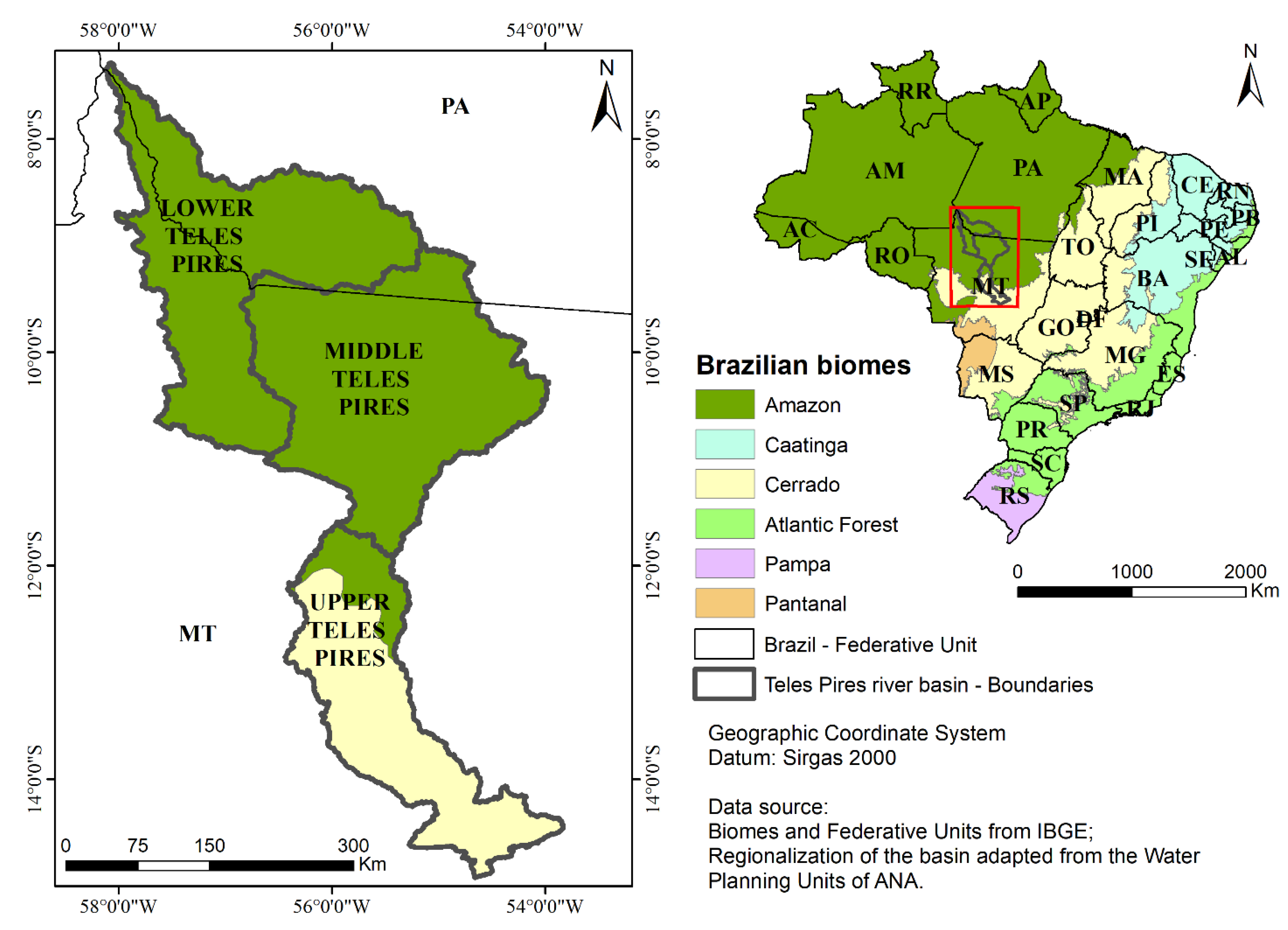

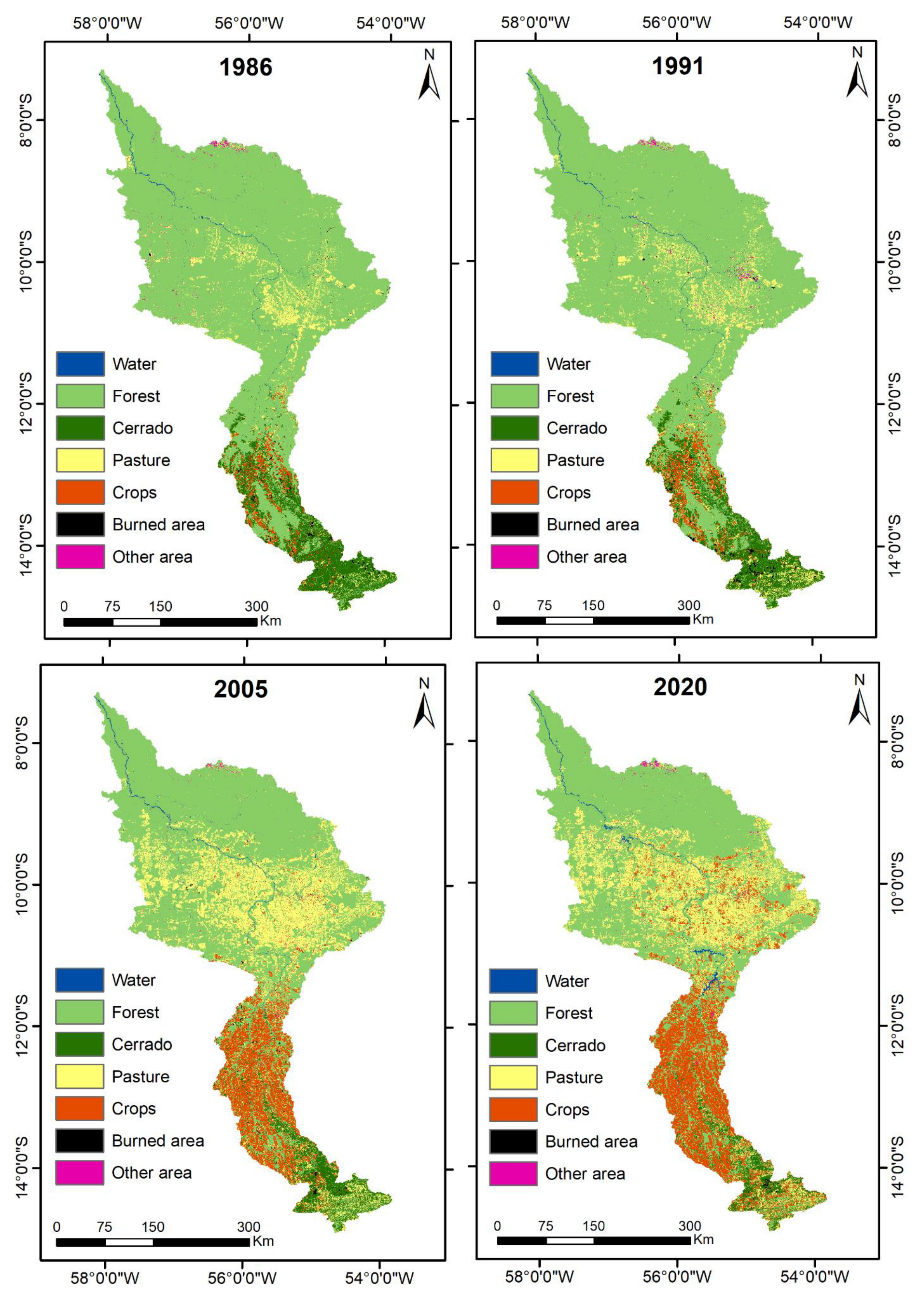
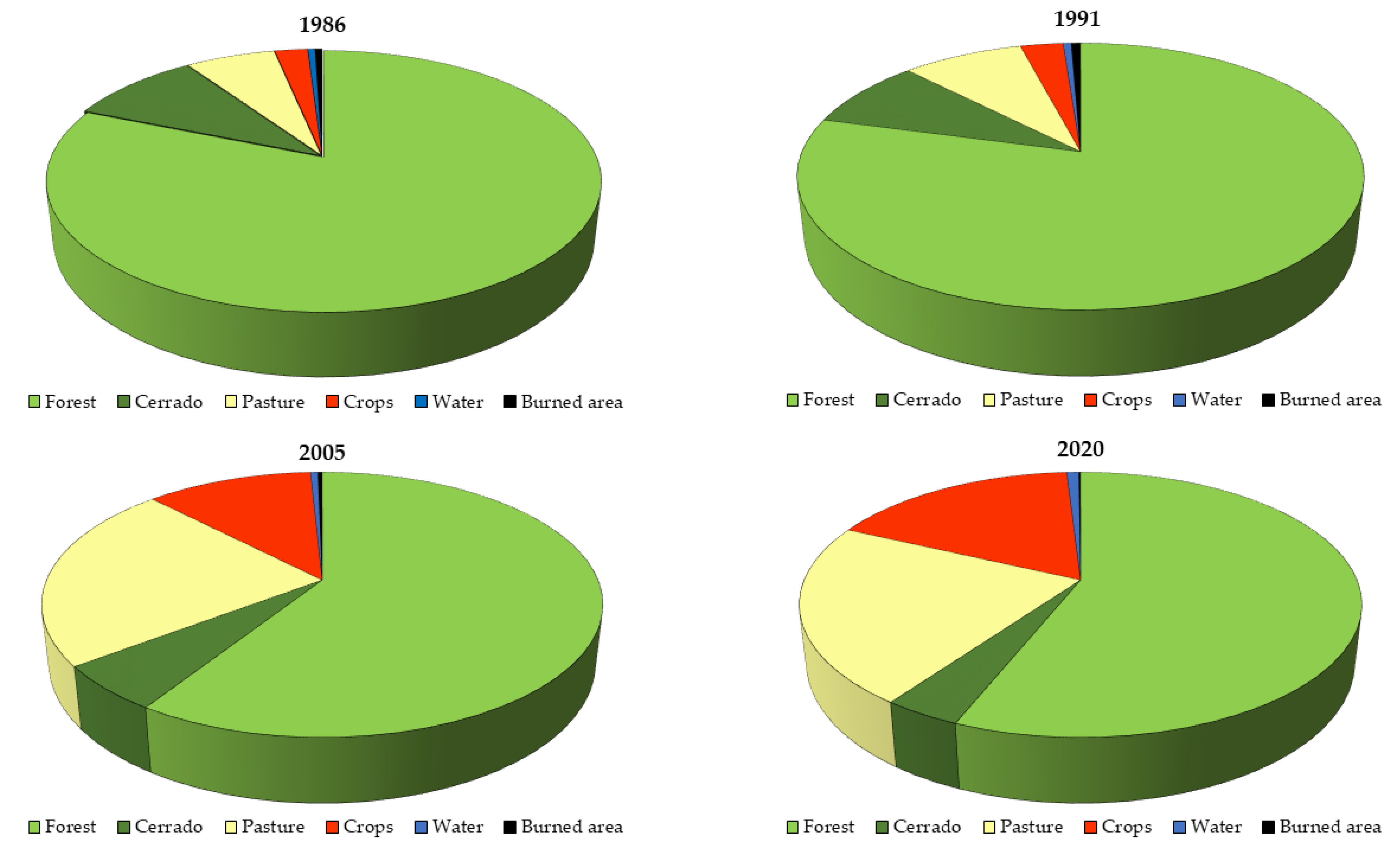
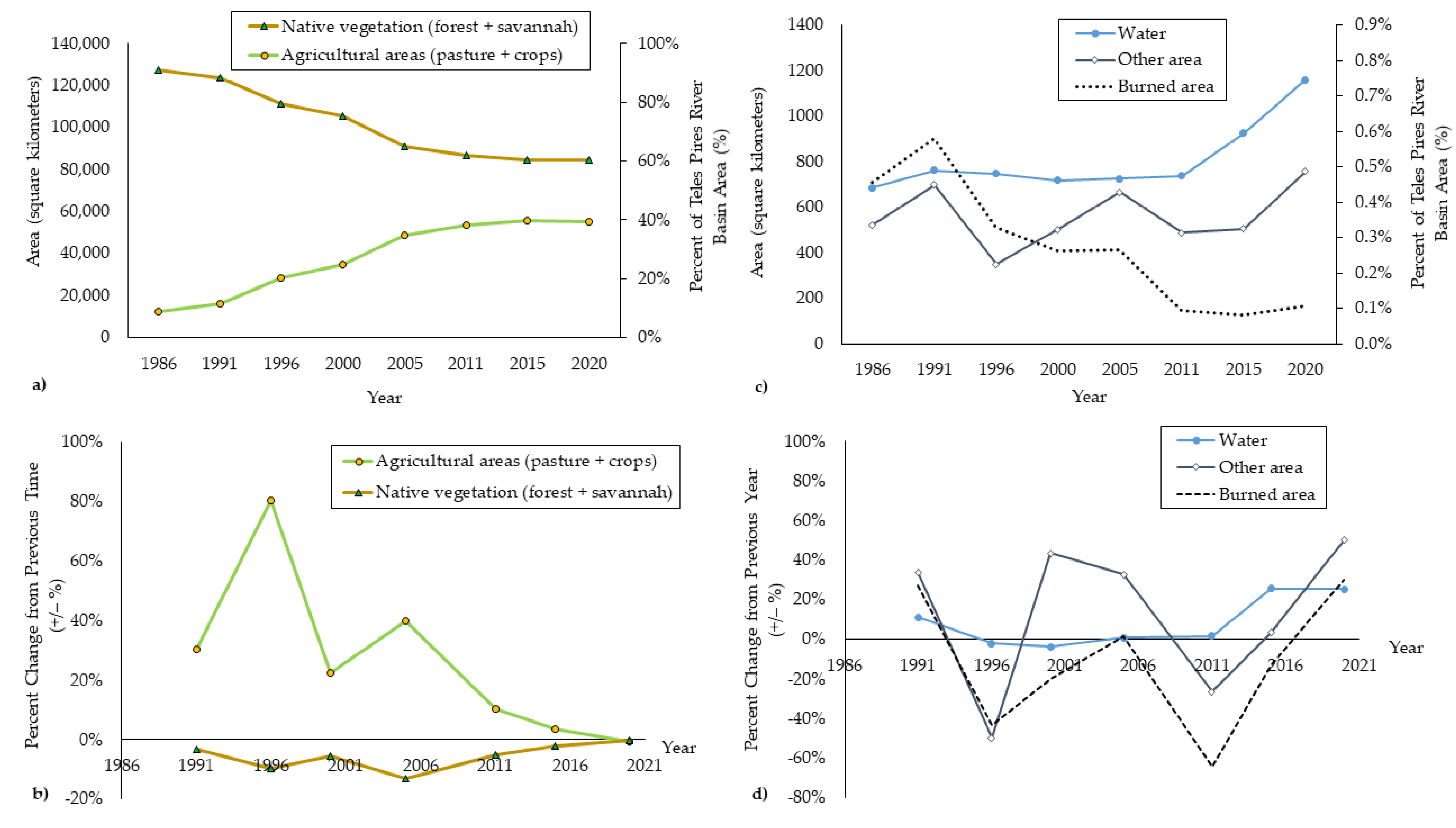
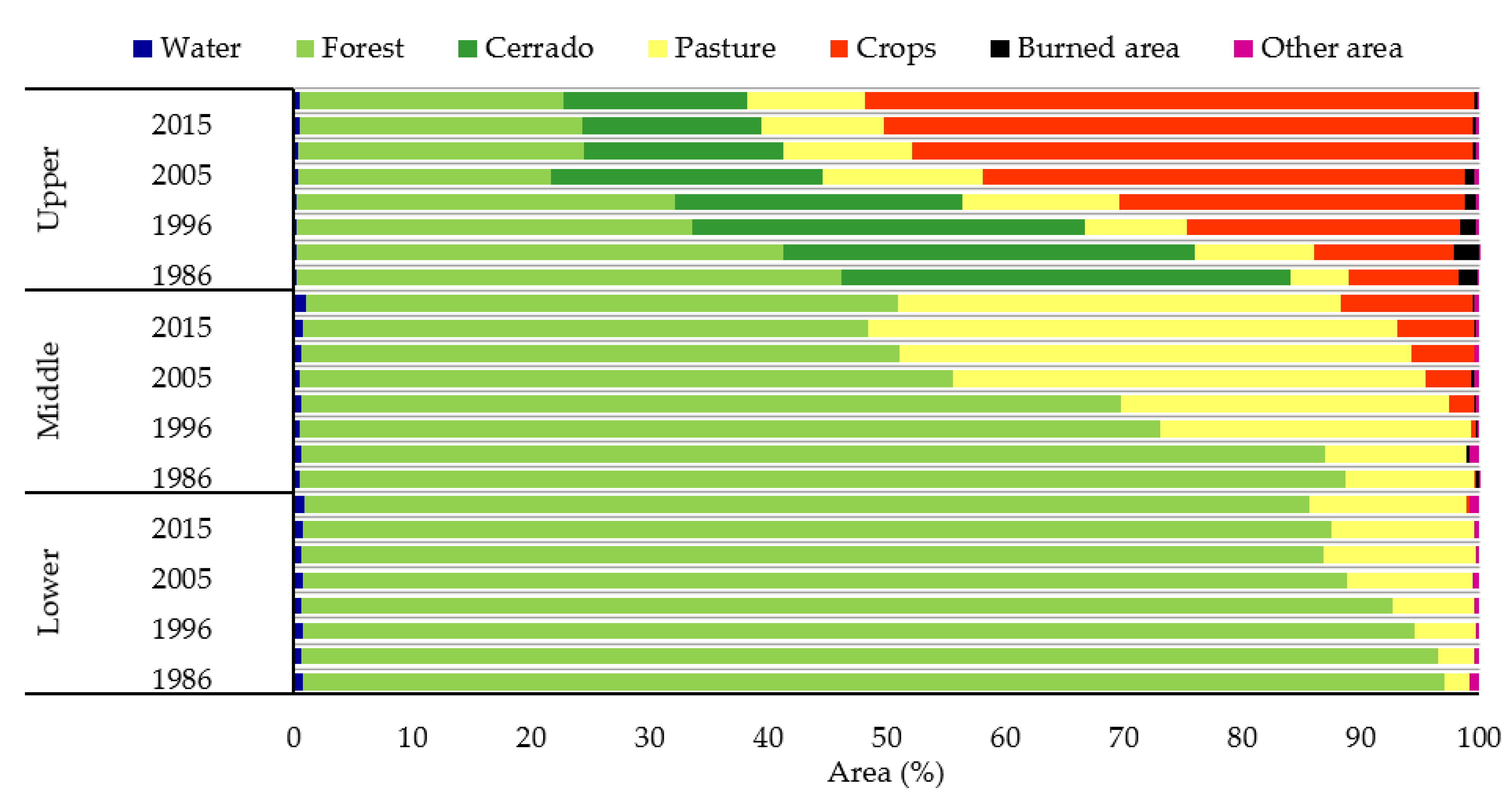
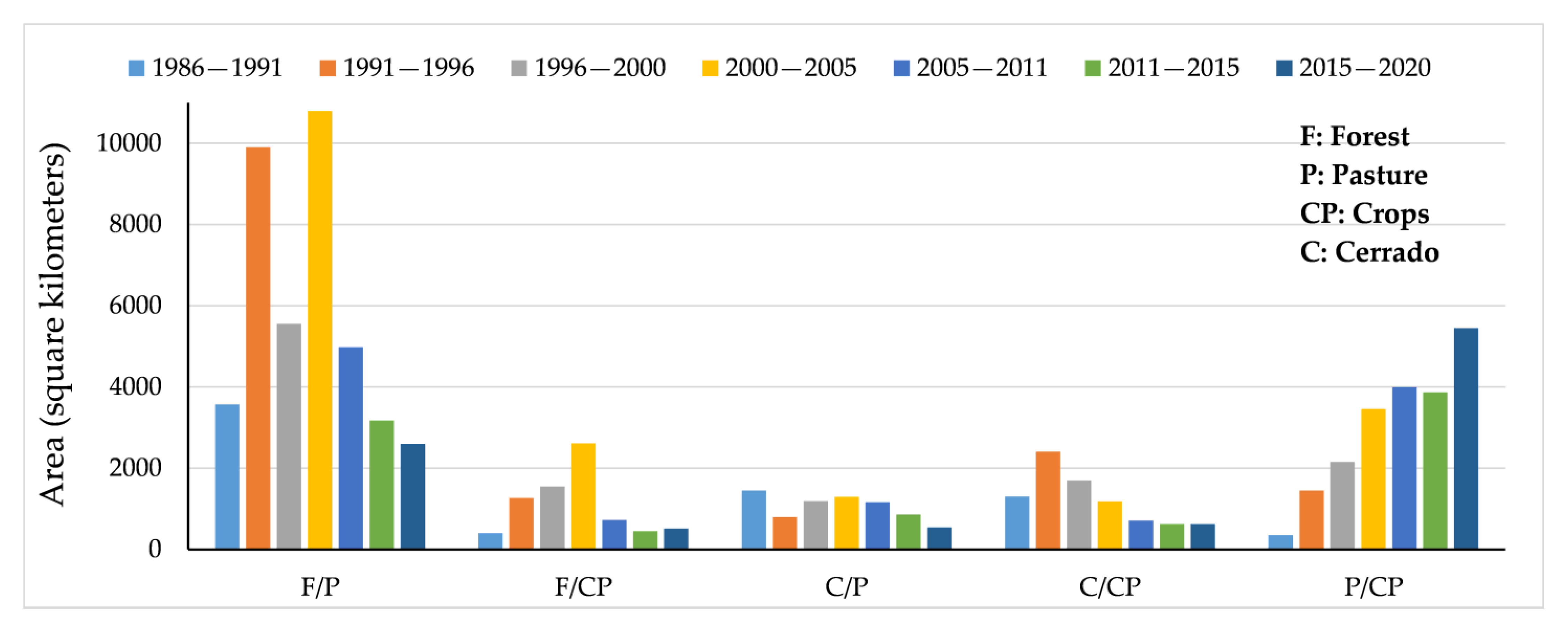
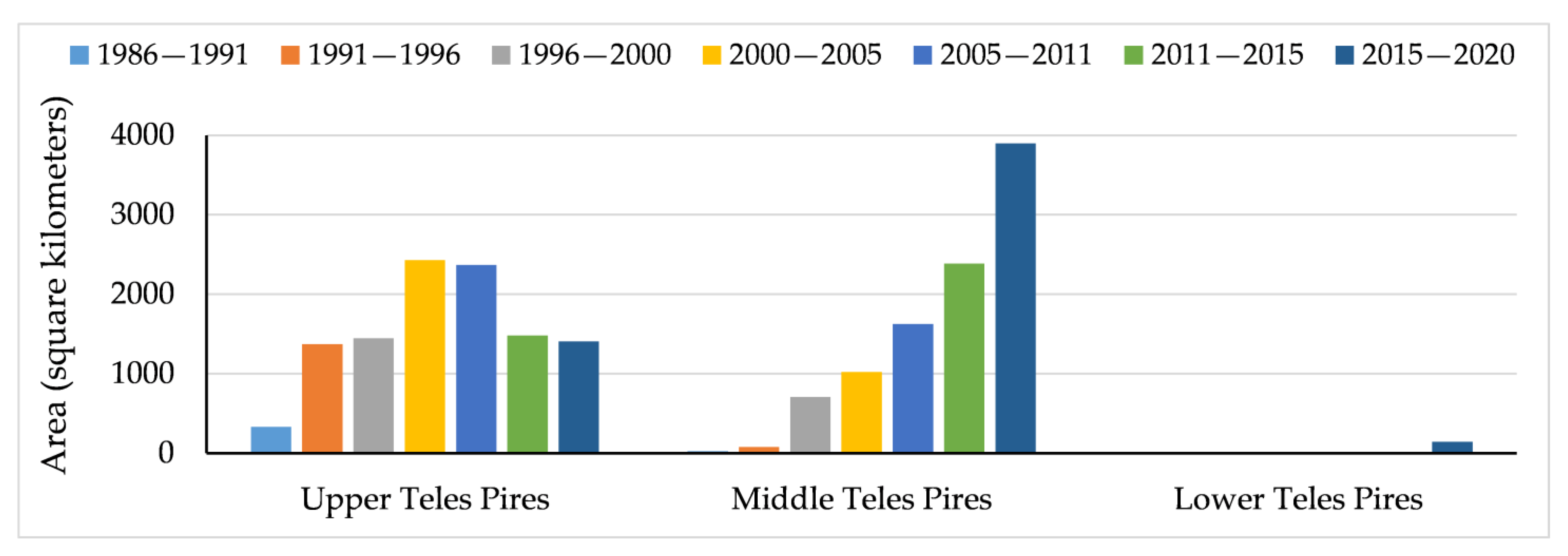
| Orbit/Point | Year | |||||||
|---|---|---|---|---|---|---|---|---|
| 1986 | 1991 | 1996 | 2000 | 2005 | 2011 | 2015 | 2020 | |
| 225/70 | 29 June | 29 July | 11 Aug. | 21 July | 17 June | 20 July | 16 Aug. | 10 June |
| 226/66 | 8 Sept. | 18 June | 1 July | 28 July | 10 July | 12 Aug. | 7 Aug. | 3 July |
| 226/67 | 8 Sept. | 20 July | 1 July | 10 June | 10 July | 12 Aug. | 7 Aug. | 3 July |
| 226/68 | 7 Aug. | 20 July | 1 July | 10 June | 26 July | 12 Aug. | 7 Aug. | 3 July |
| 226/69 | 7 Aug. | 20 July | 30 May | 10 June | 26 July | 13 Sept. | 7 Aug. | 3 July |
| 226/70 | 7 Aug. | 20 July | 1 July | 10 June | 26 July | 11 July | 7 Aug. | 3 July |
| 227/66 | 27 June | 27 July | 6 June | 17 June | 17 July | 18 July | 14 Aug. | 10 July |
| 227/67 | 27 June | 27 July | 6 June | 17 June | 17 July | 3 Aug. | 14 Aug. | 10 July |
| 227/68 | 27 June | 27 July | 6 June | 1 June | 17 July | 3 Aug. | 14 Aug. | 10 July |
| 227/69 | 27 June | 27 July | 6 June | 1 June | 17 July | 3 Aug. | 14 Aug. | 10 July |
| 228/65 | 5 Aug. | 18 July | 15 July | 10 July | 8 July | 25 July | 5 Aug. | 17 July |
| 228/66 | 5 Aug. | 18 July | 15 July | 26 July | 8 July | 25 July | 5 Aug. | 17 July |
| 228/67 | 5 Aug. | 18 July | 31 July | 26 July | 8 July | 25 July | 5 Aug. | 15 June |
| 229/65 | 28 Aug. | 26 Aug. | 23 Aug. | 17 July | 15 July | 1 Aug. | 12 Aug. | 22 June |
| Sensor | TM | TM | TM | TM | TM | TM | OLI | OLI |
| Land Use Classes | Description |
|---|---|
| Water | Surfaces covered by water, encompassing the water bodies of the basin. |
| Forest | Area of tree forest vegetation with high density of trees. |
| Cerrado | Area of vegetation with predominance of shrub stratum, showing variations with areas of low-density forest formation. |
| Pasture | Areas covered by natural or planted perennial forage intended for cattle grazing. |
| Crops | Areas intended for the cultivation of food crops, fibers, and agribusiness commodities. |
| Burned area | Surfaces that have undergone recent burning processes, with evidence of the affected areas. |
| Other area | Formed by the junction of land occupation classes with reduced spatial cover in the basin, including urban areas, mining areas, sandbanks, and rock formations. |
| Classification | MapBiomas |
|---|---|
| Water | River, lake, and ocean. |
| Forest | Forest training and silviculture. |
| Cerrado | Savanna formation, grassland formation, and other non-forest natural formations. |
| Pasture | Pasture. |
| Crops | Crops, temporary crops, sugarcane, soybeans, other temporary crops, and cotton. |
| Burned area | - |
| Other area | Urbanized area, other non-vegetated areas, and mining. |
| 1986 | 1991 | 1996 | 2000 | 2005 | 2011 | 2015 | 2020 | |
|---|---|---|---|---|---|---|---|---|
| Kappa Index | 0.96 | 0.96 | 0.97 | 0.97 | 0.97 | 0.97 | 0.97 | 0.97 |
| Overall Accuracy (%) | 98.43 | 97.97 | 98.73 | 98.03 | 98.24 | 98.49 | 98.04 | 98.46 |
| Producer Accuracy (%) | ||||||||
| Water | 100 | 100 | 100 | 100 | 100 | 100 | 100 | 100 |
| Forest | 100 | 100 | 100 | 100 | 100 | 99.99 | 100 | 99.98 |
| Cerrado | 93.27 | 94.46 | 93.44 | 91.06 | 89.93 | 92.56 | 91.97 | 95.96 |
| Pasture | 98.58 | 98.65 | 99.21 | 97.55 | 98.29 | 98.71 | 97.90 | 97.67 |
| Crops | 99.46 | 93.09 | 98.45 | 99.16 | 97.79 | 98.53 | 97.06 | 97.30 |
| Burned area | 100 | 100 | 100 | 99.93 | 100 | 100 | 99.57 | 100 |
| Other area | 75.66 | 79.45 | 86.67 | 71.70 | 79.14 | 74.60 | 74.72 | 83.50 |
| User Accuracy (%) | ||||||||
| Water | 100 | 100 | 100 | 100 | 100 | 100 | 100 | 100 |
| Forest | 98.75 | 98.88 | 98.77 | 98.18 | 98.54 | 98.81 | 98.77 | 99.18 |
| Cerrado | 100 | 100 | 100 | 100 | 100 | 100 | 100 | 99.95 |
| Pasture | 96.23 | 92.73 | 97.84 | 98.65 | 97.64 | 98.78 | 95.45 | 97.72 |
| Crops | 89.94 | 92.62 | 92.39 | 93.23 | 95.14 | 93.22 | 94.76 | 92.51 |
| Burned area | 100 | 100 | 100 | 100 | 100 | 100 | 100 | 100 |
| Other area | 100 | 100 | 100 | 100 | 100 | 100 | 100 | 100 |
| 2020 | Earthly Truth | ||||||||
|---|---|---|---|---|---|---|---|---|---|
| Water | Forest | Cerrado | Pasture | Crops | Burned Area | Other Area | Total | UA (%) | |
| Water | 42 | 0 | 0 | 0 | 0 | 0 | 0 | 42 | 100.00 |
| Forest | 0 | 346 | 7 | 1 | 1 | 0 | 0 | 355 | 97.46 |
| Cerrado | 0 | 2 | 59 | 0 | 0 | 0 | 0 | 61 | 96.72 |
| Pasture | 0 | 0 | 7 | 545 | 33 | 0 | 0 | 585 | 93.16 |
| Crops | 0 | 2 | 4 | 75 | 289 | 0 | 24 | 394 | 73.35 |
| Burned area | 0 | 0 | 0 | 0 | 0 | 0 | 0 | 0 | - |
| Other area | 0 | 0 | 0 | 0 | 0 | 0 | 40 | 40 | 100.00 |
| Total | 42 | 350 | 77 | 621 | 323 | 0 | 64 | 1477 | |
| PA (%) | 100.00 | 98.86 | 76.62 | 87.76 | 89.47 | - | 62.50 | ||
| Overall accuracy (%): | 89.44 | Kappa Index: | 0.85 | ||||||
| Land Use Classes | 1986 | 1991 | 1996 | 2000 | 2005 | 2011 | 2015 | 2020 | Percent Change 1986–2020 | |
|---|---|---|---|---|---|---|---|---|---|---|
| Water | km2 | 686.6 | 762.6 | 747.1 | 718.8 | 724.7 | 737.2 | 924.8 | 1159.1 | 68.82 |
| % of total | 0.49 | 0.54 | 0.53 | 0.51 | 0.51 | 0.52 | 0.65 | 0.82 | ||
| % change | - | 11.07 | −2.03 | −3.79 | 0.82 | 1.73 | 25.45 | 25.34 | ||
| Forest | km2 | 114,444.0 | 111,470.4 | 100,091.7 | 96,777.9 | 83,218.4 | 80,710.7 | 79,330.5 | 78,979.0 | −30.99 |
| % of total | 80.87 | 78.77 | 70.73 | 68.39 | 58.81 | 57.03 | 56.06 | 55.81 | ||
| % change | - | −2.60 | −10.21 | −3.31 | −14.01 | −3.01 | −1.71 | −0.44 | ||
| Cerrado | km2 | 13,069.5 | 11,923.2 | 11,416.0 | 8381.7 | 7927.5 | 5805.7 | 5196.4 | 5356.1 | −59.02 |
| % of total | 9.24 | 8.43 | 8.07 | 5.92 | 5.60 | 4.10 | 3.67 | 3.78 | ||
| % change | - | −8.77 | −4.25 | −26.58 | −5.42 | −26.77 | −10.49 | 3.07 | ||
| Pasture | km2 | 8839.7 | 11,658.0 | 20,248.2 | 23,533.1 | 32,385.7 | 34,423.2 | 34,643.2 | 30,988.6 | 250.56 |
| % of total | 6.25 | 8.24 | 14.31 | 16.63 | 22.89 | 24.33 | 24.48 | 21.90 | ||
| % change | - | 31.88 | 73.69 | 16.22 | 37.62 | 6.29 | 0.64 | −10.55 | ||
| Crops | km2 | 3244.0 | 4098.7 | 8150.7 | 11,194.6 | 16,177.6 | 19,201.6 | 20,787.8 | 24,105.9 | 643.09 |
| % of total | 2.29 | 2.90 | 5.76 | 7.91 | 11.43 | 13.57 | 14.69 | 17.03 | ||
| % change | - | 26.35 | 98.86 | 37.35 | 44.51 | 18.69 | 8.26 | 15.96 | ||
| Burned area | km2 | 708.4 | 902.0 | 509.9 | 406.2 | 412.3 | 145.6 | 125.9 | 163.8 | −76.87 |
| % of total | 0.50 | 0.64 | 0.36 | 0.29 | 0.29 | 0.10 | 0.09 | 0.12 | ||
| % change | - | 27.33 | −43.47 | −20.34 | 1.50 | −64.69 | −13.53 | 30.10 | ||
| Other area | km2 | 522.8 | 699.4 | 350.0 | 502.5 | 667.2 | 489.4 | 505.1 | 757.9 | 44.98 |
| % | 0.37 | 0.49 | 0.25 | 0.36 | 0.47 | 0.35 | 0.36 | 0.54 | ||
| % change | - | 33.78 | −49.96 | 43.57 | 32.78 | −26.65 | 3.21 | 50.05 | ||
| Columns = Gains for Each Class between 1986 and 2020 | ||||||||||
|---|---|---|---|---|---|---|---|---|---|---|
| Class | Water | Forest | Cerrado | Pasture | Crops | Burned Area | Other Area | Total | Losses (1986–2020) | |
| Rows = Losses for each class between 1986 and 2020 | Water | 523.50 | 145.76 | 4.04 | 4.29 | 2.00 | 0.82 | 6.11 | 686.52 | 163.03 |
| Forest | 537.86 | 76,550.19 | 925.63 | 23,232.59 | 12,694.87 | 61.91 | 421.31 | 114,424.40 | 37,874.17 | |
| Cerrado | 26.89 | 1012.66 | 4011.00 | 2081.09 | 5822.54 | 87.63 | 20.17 | 13,061.98 | 9050.97 | |
| Pasture | 40.20 | 1132.88 | 195.12 | 5055.31 | 2296.68 | 8.63 | 108.04 | 8836.86 | 3781.55 | |
| Crops | 4.57 | 21.85 | 131.03 | 245.18 | 2812.59 | 2.99 | 24.41 | 3242.62 | 430.04 | |
| Burned area | 10.49 | 33.88 | 85.85 | 167.17 | 404.29 | 1.55 | 4.93 | 708.16 | 706.61 | |
| Other area | 15.56 | 74.18 | 1.10 | 199.58 | 59.03 | 0.30 | 172.71 | 522.46 | 349.76 | |
| Total | 1159.07 | 78,971.40 | 5353.77 | 30,985.21 | 24,092.00 | 163.83 | 757.68 | |||
| Gains (1986–2020) | 635.57 | 2421.21 | 1342.77 | 25,929.90 | 21,279.41 | 162.28 | 584.98 | |||
Disclaimer/Publisher’s Note: The statements, opinions and data contained in all publications are solely those of the individual author(s) and contributor(s) and not of MDPI and/or the editor(s). MDPI and/or the editor(s) disclaim responsibility for any injury to people or property resulting from any ideas, methods, instructions or products referred to in the content. |
© 2023 by the authors. Licensee MDPI, Basel, Switzerland. This article is an open access article distributed under the terms and conditions of the Creative Commons Attribution (CC BY) license (https://creativecommons.org/licenses/by/4.0/).
Share and Cite
Kraeski, A.; de Almeida, F.T.; de Souza, A.P.; de Carvalho, T.M.; de Abreu, D.C.; Hoshide, A.K.; Zolin, C.A. Land Use Changes in the Teles Pires River Basin’s Amazon and Cerrado Biomes, Brazil, 1986–2020. Sustainability 2023, 15, 4611. https://doi.org/10.3390/su15054611
Kraeski A, de Almeida FT, de Souza AP, de Carvalho TM, de Abreu DC, Hoshide AK, Zolin CA. Land Use Changes in the Teles Pires River Basin’s Amazon and Cerrado Biomes, Brazil, 1986–2020. Sustainability. 2023; 15(5):4611. https://doi.org/10.3390/su15054611
Chicago/Turabian StyleKraeski, Aline, Frederico Terra de Almeida, Adilson Pacheco de Souza, Tania Maria de Carvalho, Daniel Carneiro de Abreu, Aaron Kinyu Hoshide, and Cornélio Alberto Zolin. 2023. "Land Use Changes in the Teles Pires River Basin’s Amazon and Cerrado Biomes, Brazil, 1986–2020" Sustainability 15, no. 5: 4611. https://doi.org/10.3390/su15054611
APA StyleKraeski, A., de Almeida, F. T., de Souza, A. P., de Carvalho, T. M., de Abreu, D. C., Hoshide, A. K., & Zolin, C. A. (2023). Land Use Changes in the Teles Pires River Basin’s Amazon and Cerrado Biomes, Brazil, 1986–2020. Sustainability, 15(5), 4611. https://doi.org/10.3390/su15054611









